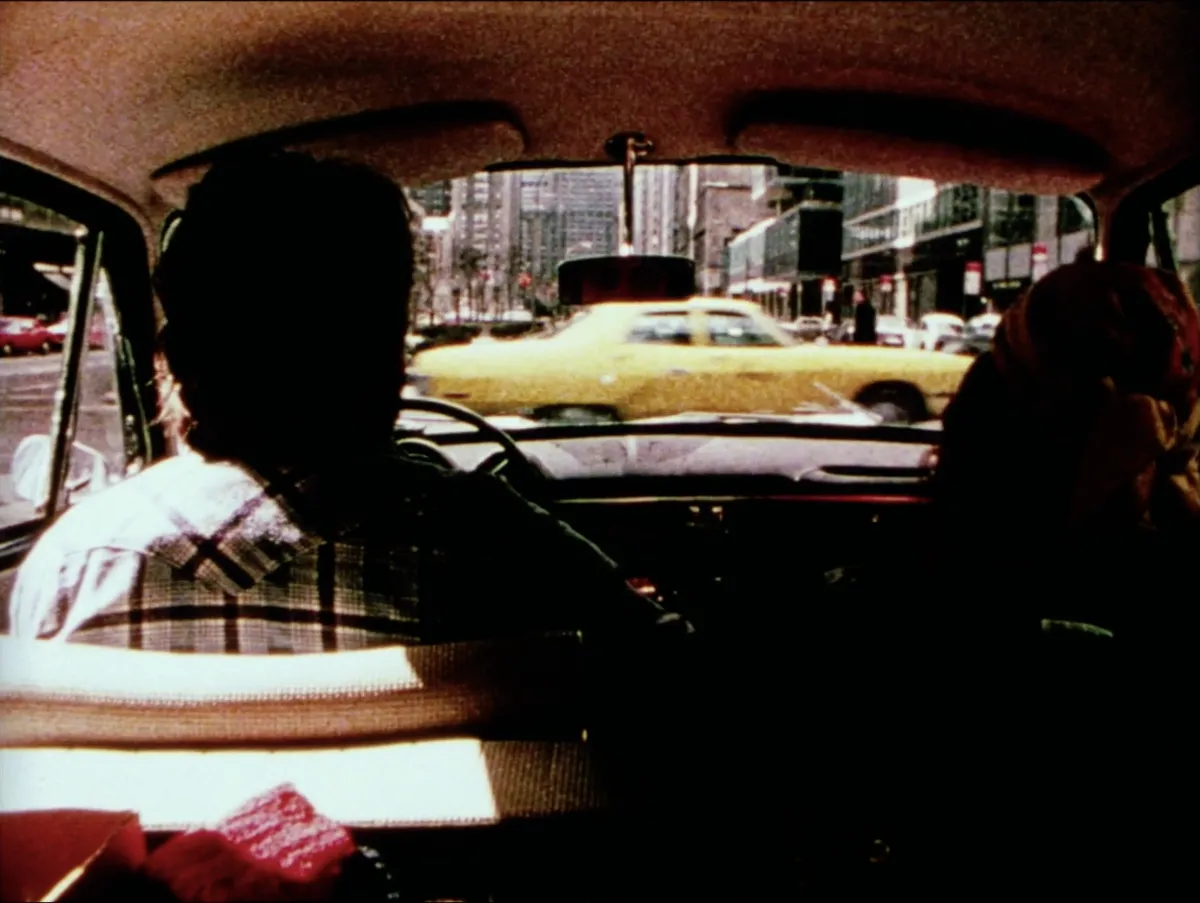

The United States of America (1975). Courtesy of Bette Gordon/Anthology Film Archive
On the brink of America’s bicentennial, two filmmakers, a then-couple, filmed their cross-country road trips from the backseat of a car. The United States of America (1975) is the 27-minute product of these journeys and directors Bette Gordon and James Benning’s third and final collaboration after Michigan Avenue (1974) and I-94 (1974). Traveling from New York City to Los Angeles, the pair is seen in silhouette in the driver and passenger seats, with the windshield essentially functioning as a screen on which various American landscapes are projected for us. This short film typified the structuralist movement of avant-garde filmmaking, while also establishing documentary strategies that carry over to today.
The United States of America offers a seemingly endless repository of “American” images: New York, Niagara Falls, Chicago, St. Louis, Archer City, Dallas, the Grand Canyon, Los Angeles, and more. Though this film is customarily discussed in conjunction with Benning’s American landscape studies, it is rooted just as much in Gordon’s pursuit of the country’s peripheral interests, which she later explores in noir-ish narratives like Empty Suitcases (1980) and Variety (1983), both works tracing America’s angry, repressed national character. These insights are drawn from a dozen hours of interviews with Gordon, including extensive reflections on The United States of America, recorded for a previously published profile on Gordon’s life and career. (I titled the piece “Bette Gordon, USA,” after the mapping of the country through her eyes.)
The trips (two of them stitched to appear as one continuous journey) emerged from Benning’s love of driving long distances; we see Gordon assuming the wheel only twice. The filmmakers opted to use Gordon’s VW station wagon—bought secondhand for $300—in lieu of Benning’s truck for its lower seats and camera access. Benning built a backseat rig using wooden planks and bolts to hold the camera in place like a tripod. His affinity for wide-angle lenses was especially handy here, as it meant Benning, Gordon, and the side windows were all visible within the frame.
As they drive, the fixed lens captures the various colors and textures of the states, with each shot dissolving into the next. The radio plays overtop: music channels (Minnie Riperton’s “Lovin’ You” plays a whopping seven times), a preacher’s sermon, news of the fall of Saigon, Patty Hearst’s capture, and the World Chess Championship. Gordon and Benning did not actually travel in silence, but would pull over and record the radio to use as a soundtrack, or they would source popular music from the library. (This “phantom radio” technique would become a staple of verité doc practices.) The complete “silences” consisted of homemade sound effects, which Gordon said she learned how to do for this film, and would prove instrumental in her debut feature Empty Suitcases in 1980. American culture became contained in this one car, mediated by these two filmmakers in transit.
In the absence of synced sound, Gordon and Benning arrange time through small gestures: the passing of a water bottle, the adjusting of the rear-view mirror, Gordon eating a banana in profile. “We choreographed ourselves. What hat am I going to wear? Should we change our clothes? Now I’m taking off my top. I’m putting my feet out the window,” Gordon recalls, in one of our interviews. There is a comfort to the lens’s point of view, like a child watching their parents from the backseat (a motif later employed in Gordon’s 1998 film Luminous Motion), or a patron at a movie theater, with a couple shuffling in the next row. The United States of America simulates communal viewing, where the windshield is a shared screen for Benning, Gordon, and us.
The landscapes often resemble matte paintings: purplish mountains, tall forests, neon signage, snowy hills, palm trees, sunsets that look like lava. One sequence even shows post-hurricane devastation in Arkansas, where the pair sped after hearing of the storm. “Everything is seen out of the car—it diminishes it,” Gordon tells me. (I think the interior view makes the outside world seem larger than ever.) This perspective also gives way to visual gags, like when the car makes a U-turn and a herd of cows is suddenly visible to the camera, or at a pit stop to a McDonald’s with Benning picking at fries on the dashboard.
Gordon and Benning did not invent the backseat vantage that The United States of America is known for, but they were the first to pull the concept into a fully-fledged film. A similar setup was seen, briefly, in Joseph H. Lewis’ 1950 noir Gun Crazy, as well as Jean-Luc Godard’s seminal Breathless ten years later—two crime films where the viewer is placed directly into the getaway car. The latter film was Gordon’s inspiration for directing and surely an influence on the composition of The United States of America.
The two major traits of The United States of America—road trip travelogue and a backseat vantage—have been adopted by many documentarians since. Take Jafar Panahi’s Taxi (2015), where the filmmaker himself drives a yellow cab through the streets of Tehran, or David Easteal’s 180-minute film The Plains (2022), where a middle-aged man’s daily commute with his younger colleague through Melbourne is captured from the backseat.
The advent of video enriched this canon of passenger voyeurism in the mid-1990s, with films like Bruce Baillie and Lorie Baillie’s Commute (1995), a hour-long drive in the rain captured by the couple, scored by a cassette tape of mock broadcasts, audio from films and Golden Age radio, and PSAs, or Sophie Calle and Greg Shephard’s No Sex Last Night (Double Blind) (1996), a coast-to-coast road trip composed of this fractured couple’s video diaries in and out of a rickety Cadillac. Given the repeated framing of a couple travelling in a vehicle, one might consider the car, despite its mobility, a domestic space. (In one of our interviews, Gordon describes the car as a “womb.”)
In 2022, Benning directed a feature-length sequel also titled The United States of America solo. At 98 minutes, the film is the structural inverse of his and Gordon’s venture, composed of 52 static shots, approximately two minutes each, alphabetically representing each U.S. state plus Washington, D.C., and Puerto Rico. Where the 1975 short was characterized by its momentum—a uniform field of vision with a constant flow of images—Benning’s addendum uses these languid, unbroken shots to rewrite Americana in a different direction. It’s revealed at the end of the 2022 film that every representative shot was filmed in California, betraying a kind of performance of statehood and national signifiers. It’s a playful twist, but also literalizes the editing strategy of The United States of America of 1975, where the shots and states melt into each other, with the windshield acting as an impressionistic equalizer.
Critic Dennis Cooper called The United States of America (1975) a “pure road movie, absent of character goals or desire, but attentive to the movement of history and fixity of geography.” He also noted that “the film is shot from what in Hollywood is described, cheatingly, as an over-the-shoulder POV, but here, since the camera is midway between the left shoulder of one person and the right shoulder of the other, the shot is an amalgam of two supposed POVs, i.e., a double cheat.” From a documentary perspective, this double cheat (or double blind, as per Calle) might actually be a half truth, with the authors semi-visible to us throughout. The secretive elements of the drive—how Gordon and Benning communicated underneath the inserted audio—feels uniquely American: invisible labor buried within beautiful images; private conversations covered up by pop music and the news; careful artifice and genuine craft.
Fifty years on, The United States of America is most readily spoken about as a visual archive, like an assemblage of postcards. Its unpretentious but nevertheless choreographed tactics inaugurated a documentary style that bridged the mutual construction of sound, image, and place. While the work does not feel anti-American, the flattening of the country (in Gordon’s view) into highway vignettes and faux-radio excerpts on its bicentennial seems a parodic exercise. The final minute of the film is as gratifying and unostentatious as the rest: waves lapping on the Californian shore and nobody in the front seat—a driverless car parked on the edge of a shimmering expanse to send us back into an America of a different ilk.
Saffron Maeve is a Toronto-based critic and curator.




